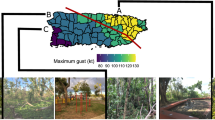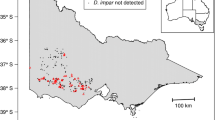Abstract
Black-tailed prairie dogs (Cynomys ludovicianus) are a key component of the disturbance regime in semi-arid grasslands of central North America. Many studies have compared community and ecosystem characteristics on prairie dog colonies to grasslands without prairie dogs, but little is known about landscape-scale patterns of disturbance that prairie dog colony complexes may impose on grasslands over long time periods. We examined spatiotemporal dynamics in two prairie dog colony complexes in southeastern Colorado (Comanche) and northcentral Montana (Phillips County) that have been strongly influenced by plague, and compared them to a complex unaffected by plague in northwestern Nebraska (Oglala). Both plague-affected complexes exhibited substantial spatiotemporal variability in the area occupied during a decade, in contrast to the stability of colonies in the Oglala complex. However, the plague-affected complexes differed in spatial patterns of colony movement. Colonies in the Comanche complex in shortgrass steppe shifted locations over a decade. Only 10% of the area occupied in 1995 was still occupied by prairie dogs in 2006. In 2005 and 2006 respectively, 74 and 83% of the total area of the Comanche complex occurred in locations that were not occupied in 1995, and only 1% of the complex was occupied continuously over a decade. In contrast, prairie dogs in the Phillips County complex in mixed-grass prairie and sagebrush steppe primarily recolonized previously occupied areas after plague-induced colony declines. In Phillips County, 62% of the area occupied in 1993 was also occupied by prairie dogs in 2004, and 12% of the complex was occupied continuously over a decade. Our results indicate that plague accelerates spatiotemporal movement of prairie dog colonies, and have significant implications for landscape-scale effects of prairie dog disturbance on grassland composition and productivity. These findings highlight the need to combine landscape-scale measures of habitat suitability with long-term measures of colony locations to understand the role of plague-affected prairie dogs as a grassland disturbance process.





Similar content being viewed by others
References
Anderson RC (1990) The historic role of fire in the North American grassland. In: Collins SL, Wallace LL (eds), Fire in North American tallgrass prairies. University of Oklahoma Press, Norman, pp 8–18
Antolin ML, Savage L, Eisen R (2006) Landscape features influence genetic structure of black-tailed prairie dogs (Cynomys ludovicianus). Landsc Ecol 21:867–875
Archer S, Garrett MG, Detling JK (1987) Rates of vegetation change associated with prairie dog (Cynomys ludovicianus) grazing in North American mixed-grass prairie. Vegetation 72:159–166
Bailey D, Gross J, Laca E, Rittenhouse L, Coughenour M, Swift D, Sims P (1996) Mechanisms that result in large herbivore grazing distribution patterns. J Range Manag 49:386–400
Carlson D, White E (1987) Effects of prairie dogs on mound soils. Soil Sci Soc Am J 51:389–393
Cid MS, Detling JK, Whicker AD, Brizuela MA (1991) Vegetational responses of a mixed-grass prairie site following exclusion of prairie dogs and bison. J Range Manag 44:100–105
Cincotta RP (1985) Habitat and dispersal of black-tailed prairie dogs in Badlands National Park. PhD Dissertation, Department of Biology, Colorado State University, Fort Collins, CO
Collinge S, Johnson W, Ray C, Matchett R, Grensten J, Cully J, Gage K, Kosoy M, Loye J, Martin A (2005a) Testing the generality of a trophic-cascade model for plague. EcoHealth 2:1–11
Collinge S, Johnson W, Ray C, Matchett R, Grensten J, Cully J, Gage K, Kosoy M, Loye J, Martin A (2005b) Landscape structure and plague occurrence in black-tailed prairie dogs on grasslands of the western USA. Landsc Ecol 20:941–955
Collins SL, Barber SC (1985) Effects of disturbance on diversity in mixed-grass prairie. Vegetation 64:87–94
Coppock DL, Ellis JE, Detling JK, Dyer MI 1983. Plant-herbivore interactions in a North American mixed-grass prairie. I. Effects of black-tailed prairie dogs on intrasesonal aboveground plant biomass and nutrient dynamics. Oecologia 56:10–15
Coughenour M (1991) Spatial components of plant-herbivore interactions in pastoral, ranching, and native ungulate ecosystems. J Range Manag 44:530–542
Cully JF, Williams ES (2001) Interspecific comparisons of sylvatic plague in prairie dogs. J Mammal 82:894–905
Cully JK, Biggins DE, Seery DB (2006) Conservation of prairie dogs in areas with plague. In: Hoogland JL (ed), Conservation of the blacktailed prairie dog. Island Press, Washington, pp 157–168
Derner JD, Detling JK, Antolin MF (2006) Are livestock weight gains affected by black-tailed prairie dogs? Front Ecol Environ 4:459–464
Detling JK (2006) Do prairie dogs compete with livestock? In: Hoogland JL (ed), Conservation of the black-tailed prairie dog. Island Press, Washington, pp 65–88
Detling JK (1998) Mammalian herbivores: ecosystem-level effects in two grassland national parks. Wildl Soc Bull 26:438–448
Fahnestock J, Detling JK (2002) Bison-prairie dog-plant interactions in a North American mixed-grass prairie. Oecologia 132:86–95
Frank DA, McNaughton SJ, Tracy BF (1998) The ecology of the earth’s grazing ecosystems: comparing the Serengeti and Yellowstone. BioScience 48:513–521
Garrett MG, Franklin WL (1988) Behavioral ecology of dispersal in the blacktailed prairie dog. J Mammal 69:236–250
Garrett MG, Hoogland JL, Franklin WL (1982) Demographic differences between an old and new colony of black-tailed prairie dogs (Cynomys ludovicianus). Am Midl Nat 108:51–59
Hartley LM (2006) Plague and the black-tailed prairie dog: an introduced disease mediates the effects of an herbivore on ecosystem structure and function. PhD Dissertation, Department of Biology, Colorado State University, Fort Collins, CO
Johnson TL (2005) Spatial dynamics of a bacterial pathogen: sylvatic plague in black-tailed prairie dogs. MS Thesis, Department of Biology, Kansas State University, Manhattan, KS
Johnson-Nistler CM, Sowell BF, Sherwood HW, Wambolt CL (2004) Black-tailed prairie dog effects on Montana’s mixed-grass prairie. J Range Manag 57:641–648
Knapp A, Blair J, Briggs J, Collins S, Hartnett D, Johnson L, Towne E (1999) The keystone role of bison in North American tallgrass prairie. BioScience 49:39–50
Knowles CJ, Knowles PR (1994) A review of black-tailed prairie dog literature in relation to rangelands administered by the Custer National Forest. U. S. Dep. Agric. For. Serv. 61p
Kotliar NB, Baker BW, Whicker AD, Plumb GE (1999) A critical review of assumptions about the prairie dog as a keystone species. Environ Manag 24:177–192
Kretzer JE, Cully JF (2001) Effects of black-tailed prairie dogs on reptiles and amphibians in Kansas shortgrass prairie. Southwest Nat 46:171–177
Krueger KA (1986) Feeding relationships among bison, pronghorn and prairie dogs: an experimental analysis. Ecology 67:760–770
Lauenroth W, Milchunas D (1991) Short-grass steppe. In: Coupland R (ed), Ecosystems of the world. Elsevier, New York, pp 183–226
Lomolino MV, Smith GA (2001) Dynamic biogeography of prairie dog (Cynomys ludovicianus) towns near the edge of their range. J Mammal 82:937–945
Lomolino MV, Smith GA (2003) Terrestrial vertebrate communities at black-tailed prairie dog (Cynomys ludovicianus) towns. Biol Conserv 115:89–100
Miller SD, Cully JF (2001) Conservation of black-tailed prairie dogs (Cynomys ludovicianus). J Mammal 82:889–893
Proctor J, Haskins B, Forrest SC (2006) Focal areas for conservation of prairie dogs and the grassland ecosystem. In: Hoogland JL (ed), Conservation of the black-tailed prairie dog. Island Press, Washington, pp 232–247
Reading RM, Matchett R (1997) Attributes of black-tailed prairie dog colonies in north-central Montana. J Wildl Manag 61:664–673
Roach JL, Stapp P, Van Horne B, Antolin MF (2001) Genetic structure of a metapopulation of black-tailed prairie dogs. J Mammal 82:946–959
Roe K, Roe C (2003) Habitat selection guidelines for black-tailed prairie dog relocations. Wildl Soc Bull 31:1246–1253
Senft RL, Coughenour MB, Bailey DW, Rittenhouse L (1987) Large herbivore foraging and ecological hierarchies. BioScience 37:789–799
Sidle JG, Johnson DH, Euliss BR (2001) Estimated areal extent of colonies of black-tailed prairie dogs in the northern Great Plains. J Mammal 82:928–936
Sidle, JG, Schenbeck, GL, Lawton, EA, Licht, DS (2006) Role of federal lands in the conservation of prairie dogs. In: Hoogland JL (ed), Conservation of the black-tailed prairie dog. Island Press, Washington, pp 218–231
Smith G, Lomolino M (2004) Black-tailed prairie dogs and the structure of avian communities on the shortgrass plains. Oecologia 138:592–602
Sousa WP (1984) The role of disturbance in natural communities. Annu Rev Ecol Syst 15:353–391
Stapp P, Antolin MF, Ball M (2004) Patterns of extinction in prairie dog metapopulations: plague outbreaks follow El Niño events. Front Ecol Environ 2:235–240
Toombs TP (1997) Burrowing owl nest-site selection in relation to soil texture and prairie dog colony attributes. M.S. thesis. Colorado State University, Fort Collins, Colorado. 73 p
Truett J, Dullum J, Matchett M, Owens E, Seery D (2001) Translocating prairie dogs: a review. Wildl Soc Bull 29:863–872
Turner MG, Bratton SP (1985) Fire, grazing and the landscape heterogeneity of a Georgia barrier island. In: Turner MG (ed), Landscape heterogeneity and disturbance. Springer-Verlag, New York, pp 85–102, 239
Uresk DW (1985) Effects of controlling black-tailed prairie dogs on plant production. J Range Manag 38:466–468
Weltzin JF, Dowhower SL, Heitschmidt RK (1997) Prairie dog effects on plant community structure in southern mixed-grass prairie. Southwest Nat 42:251–258
Whicker A, Detling JK (1988) Ecological consequences of prairie dog disturbances. BioScience 38:778–785
White GR, Dennis PF (2005) Area of black-tailed prairie dog colonies in eastern Colorado. Wildl Soc Bull 33:265–272
Winter SL, Cully JF, Pontius JS (2002) Vegetation of prairie dog colonies and non-colonized shortgrass prairie. J Range Manag 55:502–508
Wright HA, Bailey AW (1982) Fire ecology: United States and Canada. John Wiley and Sons, New York
Woodyard SO, Preator RE, Moreland RE, McCullough MB (1973) Soil survey of Baca County, Colorado; United States Department of Agriculture, Soil Conservation Service. US Government Printing Office, Washington
Acknowledgements
We thank John Grensten and Valerie Kopcso from the Bureau of Land Management in Malta Montana, along with numerous other cooperators, interns and technicians for collecting the Phillips County prairie dog mapping data. We thank Jeff Abbeglin and Jason Brewer for collecting the Oglala National Grassland prairie dog mapping data. We thank Thomas Peters for supporting the prairie dog mapping efforts on the Comanche National Grassland. M. F. Antolin, J. L. D. Dullum and an anonymous reviewer provided helpful comments the manuscript. Funding was provided by the USDA—Forest Service, USDA—Agricultural Research Service, USDI—Bureau of Land Management, and the Kansas Cooperative Fish and Wildlife Research Unit.
Author information
Authors and Affiliations
Corresponding author
Additional information
The U.S. Government’s right to retain a non-exclusive, royalty-free license in and to any copyright is acknowledged.
Rights and permissions
About this article
Cite this article
Augustine, D.J., Matchett, M.R., Toombs, T.P. et al. Spatiotemporal dynamics of black-tailed prairie dog colonies affected by plague. Landscape Ecol 23, 255–267 (2008). https://doi.org/10.1007/s10980-007-9175-6
Received:
Accepted:
Published:
Issue Date:
DOI: https://doi.org/10.1007/s10980-007-9175-6




